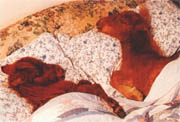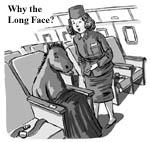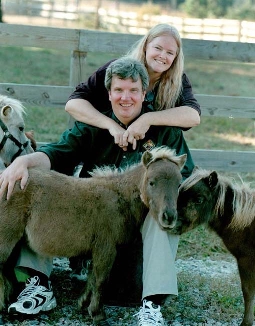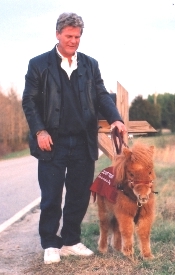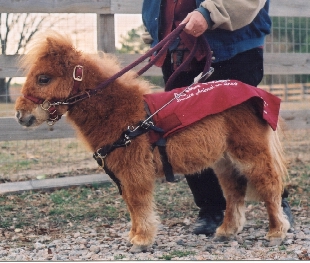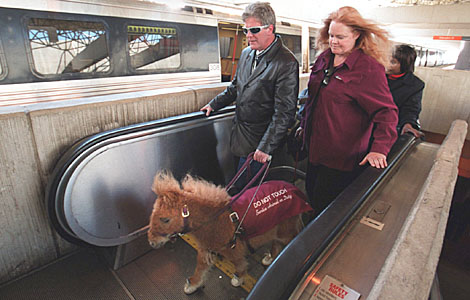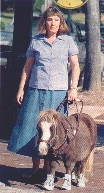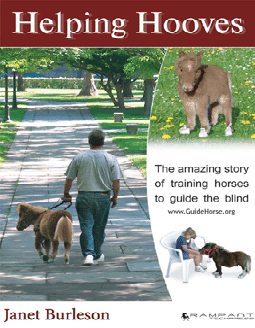|
The Guide Horse
Foundation |
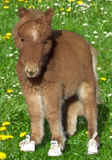 |
|
Common Misconceptions about Guide Horses The pioneering use of Guide Horses has led to numerous misconceptions about the role and use of miniature horses as guides for the blind. For more answers, see our FAQ pages on horse question and guide horse training questions. Misconception: Guide Horses compete with guide dogs The Guide Horse Foundation
loves guide dogs and often recommends guide dog schools to blind
applicants. Blind people have very few mobility options, and must
rely on a cane, a human guide or a guide dog. The Guide Horse
foundation was created to give blind people another mobility option. A
Guide Horse is a personal preference, and Guide Horses are not for
everyone,. The Guide Horse Foundation caters to horse lovers, those
who need a guide with a long lifespan, blind equestrians who ride large
horses, and blind people with dog allergies. Misconception: The Guide Horse Foundation breeds horses Miniature horses have a wide variation in size and it is
not practical to breed them. The Guide Horse Foundation relies on
donations from large breeding farms and individual donations. Less
than 1% of miniature horses are suitable for the Guide Horse program,
and all horses must have exceptional small size, physical health and
above average intelligence. Misconception: The GHF places dwarf horses as guides The Guide Horse
Foundation does not place dwarf horses as guides. While a dwarf miniature
horse (Twinkie) was used as a prototype horse during the years
spent developing and refining the training program, the GHF only places
physically sound horses with exceptional stamina and we
seek exceptionally small, correct horses with good conformation and sound
legs for the Guide Horse program. Only those horses found healthy by
a licensed equine veterinarian are accepted into the Guide Horse program. Misconception: Guide Horses must live indoors While Guide Horses are
trained to work indoors while guiding, all Guide Horses handlers are required to
have a fenced outdoor area and barn for when their Guide Horse is off duty. All
horses require lots of fresh air, and all Guide Horses live outdoors when
not guiding. Misconception: Guide Horses live lonely lives Just as dogs are pack
animals, horses are happier when they have a friend to come home to after work. While it is
not considered uncommon or cruel for a horse or dog to live alone, the Guide Horse
Foundation considers the feelings of the horse and always places a companion horse with each Guide Horse. Misconception: Guide animals must know where their handler wants to go All guide animals rely on
commands from their handler to tell them where to go. Even the
best-trained animal are not psychic and must rely on their handler to give
them navigational signals. Guide horses must master 23 voice
commands and their handlers must pass a test demonstrating that they
possess the orientation and mobility skills necessary to safely navigate
with a guide animal. Misconception: A Guide Horse might "spook" The Guide Horse Foundation is acutely aware that the blind people entrust their lives to their guide. All Guide Horses undergo the same systematic desensitization training that is used by riot-control horses and Cavalry horses. Guide Horses must learn to "spook in place" and they must master this skill to 100% proficiency.
All Guide horses learn exactly the same behaviors as a guide dog, and the GHF spent several years carefully developing and refining the training program. All Guide Horses must demonstrate 100% proficiency at keeping their handler safe in chaotic traffic, and no Guide Horse is placed until their handler can confidently place their life in its control. Guide Horses have proven to be exceptionally talented in keeping their handler safe in traffic, partially because their 350 degree range of vision allows them to see traffic in all directions at the same time. Misconception: Guide animals are easy to train Training any guide animal requires many years of full-time training experience because the blind people entrust their lives to their horses. Janet Burleson, the first person in the world to train a Guide Horse, is a retired professional horse trainer with more than 30 years of full-time horse training experience. Noted as one of the world's pioneering horse trainers by Practical Horseman Magazine, Janet Burleson is considered a leading authority on horse training techniques. Janet spent several years researching Guide animal training before developing her revolutionary program, performing an exhaustive review of all published guide animal books and working extensively with professional guide animal trainers and blind guide dog users.
This page describes the miniature horse and the miniature horse health, miniature horse care, miniature horse characteristics, and the miniature horse registries and miniature horse health. We also have miniature horse feeding, miniature horse grooming and miniature horse vision. We also cover miniature horse allergies, miniature horse acceptance, and the miniature horse as a guide. |
Guides Training Press Photos News Apply FAQ Wishes Contact Home
|
|
Copyright © 1998 - 2005 by the Guide Horse Foundation Inc. Guide Horse ® Guidehorse ® and Helping Hooves ® are registered trademarks. |
The Guide Horse Foundation has the utmost respect for The Seeing Eye® and their seventy-two years of outstanding work with assistance animals for the blind. Even though the press often calls our horses "seeing eye horses", please note that The Guide Horse Foundation is not affiliated with or sanctioned by the Seeing-Eye® or any of the Guide Dog training organizations. Seeing-Eye® is a registered trademark of the Seeing-Eye, Inc.
Golf Instruction
Open wonderful agar game and become biggest on the map! . Смотрите описание sandalias mujer у нас.